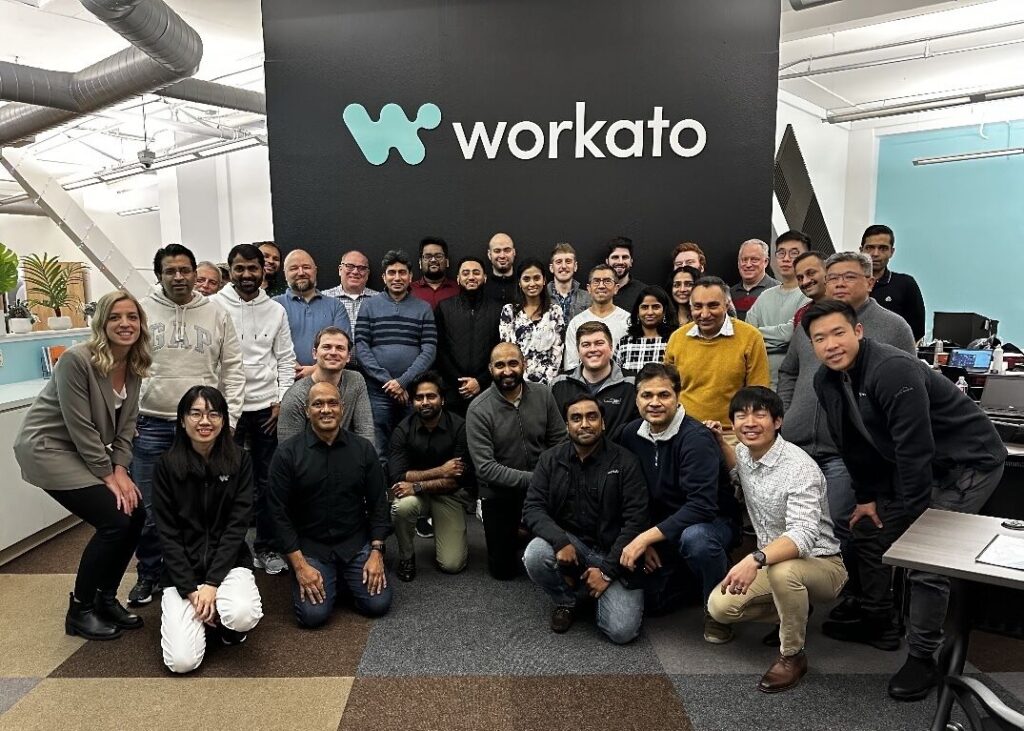Content Sponsored by Expent
“Procurement is a specialised field that plays a crucial role in delivering tangible value that supports growth, promotes innovation, builds resilience and drives value through efficiency,” notes Ashim Kapai, Senior Director and Head of Strategic Sourcing and Procurement at Workato. Since arriving in early 2022, he has aimed to merge the best of the company’s innovation with market-leading platforms, to revolutionise Workato’s procurement approach.
Hi Ashim. Perhaps you could begin by introducing Workato, its core service mission, and how you came to be a part of its ongoing evolution?
Workato is a unified integration and automation platform that allows an end user to connect many disparate systems and to facilitate them talking to each other. As such, it is a low code/no code platform that enables individuals with no technical knowledge to navigate the automation landscape.
I have almost completed a year here at Workato and was brought in specifically to build and scale the procurement organisation, and it’s definitely been a fun ride. 2021 was certainly different to 2022 which was a whole new ballgame. It has been exciting, but has added a certain pressure to evolve our procurement function in a way that allows us to navigate the uncertainties of 2023.
Click Below: view the magazine version of this content
You mentioned 2021 and 2022 there, and I’m sure the impacts of 2020 are still lingering too. To that end, what were the specific challenges and bottlenecks you encountered when entering the organisation a year ago?
You’re absolutely right – it’s been a trickle-down effect of the past three years as a whole, in terms of supply chain disruption which highlighted the vulnerability of traditional operating models that many procurement professionals are trying to navigate even today. These shortcomings include a lack of reliable long-term planning, growing concentration of supply, limited insight into supplier economics, a lack of collaboration across functional teams, and a failure to adopt and scale proven technologies that could reduce transactional loads.
However, we know from studies related to the financial crisis of ‘08/’09 that companies who invested during the downturn were the ones who outperformed post-downturn. How companies respond today positions them to outperform in the future. It is not about bringing spending to a standstill. For us, it was more around embracing and executing a mindset shift that focused on growth with efficiency, rather than ‘growth at all costs’.
At this time, inevitably, there is more scrutiny of investments – how we spend money, how new technology is actually influencing operations, and how new adoptions are optimising work across lots of different categories.
So, where did you start?
Procurement is a specialised field that plays a crucial role in delivering tangible value, supporting growth, promoting innovation, and building resiliency for governments and organisations.We proceeded under the strategy of enacting a responsible procurement transformation. I’ve been in the procurement space for a long time and have worked through similar challenges and transformations in the past, but every organisation is different and requirements can be quite specific and unique.

We knew that we had to address two distinct fronts as we built out our core procurement infrastructure: move decision-making upstream, via a centralised procurement intake system; and across the approvals and finance processes through a dedicated procure-to-pay (P2P) solution.
First, we needed a structure around this end-to-end concept. In the absence of a core procurement infrastructure, it’s difficult to navigate the space. Absence of a centralised procurement intake workflow causes teams to rely on emails for legal, business technology and security approvals; or indeed on spreadsheets and ad-hoc storage of contracts. Both increase the likelihood of something falling through the cracks while also increasing administrative work. So, really, the starting point was putting a structure and framework in place around the whole procurement process. Our team knew we had the innovation in-house to help with that.
So, you looked internally to kickstart the process?
There is extra pressure around any form of digital transformation, because we ourselves are a facilitator of innovation – we have to be seen to be getting this right. Workato is an integration and automation platform that allows companies to automate processes through recipes, tasks and connectors rather than having a specialist sit down and build those connections or to make integrations work.
In turn, the platform allows more people within their organisation to become experts in their fields, creating a trickle effect of efficiency and interconnectivity, through automation.
And if that’s what we’re offering to our clients, why not practice what we preach and deploy our own solutions to improve our procurement function, too?
That’s what we did – we have deployed our own automation solutions to connect the platforms and solutions brought into Workato’s ecosystem. Rather than building an integration to multiple point solutions, we are leveraging Workato which allows these best-in-class solutions to talk to each other and make information flow seamless, without the need to engage IT resources to build those integrations.
You’ve mentioned the importance of structure, and how some of your own tools could fit within it. But how did you go about beginning to fill the gaps within this idea of a structure?
It mostly revolved around a need to put some guardrails up around how we spend, so that when we assess ROI, there is a clearer rationale and path behind our decisions, and what they resulted in.
For context, when I arrived in January 2022, the tool of choice in the market for putting a P2P platform in place was Coupa – the undisputed leader in the space. I’m saying this as a customer of several years and also as a former Director of Strategic Sourcing & Procurement Operations at Coupa. No other platform can deliver what it can from a procurement perspective, and I had familiarity with it.
Immediately, through this addition, we achieved that structure around P2P, implicating operations like invoicing and expense management. What it also did was bring governance and control around spending and investments. This immediately makes you more efficient as you always have the right teams weighing in on necessary spending categories.
And you mentioned the importance of centralised intake processes as the second core aspect of this transition?
Absolutely – centralised procurement intake workflow serves as an orchestration layer enabling cross-functional teams to collaborate successfully. The centralised intake process helps organisations gain visibility and control over spend and liquidity, prevent unplanned spend, mitigate third-party risk through proper due diligence, and increase agility to adapt as supply chain priorities change through diversification. The way we have deployed this at Workato – while leveraging the power of Workato – is providing access to users to put in procurement requests as a direct pathway to the due diligence, data analysis, legal and business justification processes. That immediately follows through the P2P platform, by leveraging Workato connectors.
In order to coordinate these upstream checks and balances outside of Coupa, I relied on a centralised procurement intake process that I initially put in place in 2017, and then evolved in 2020. In 2022, as I searched for a scalable platform to support the centralised procurement intake workflow, I chose Expent.ai, who – based on my previous work and feedback – have built a platform to support the centralised procurement intake process. The Expent.ai founders have built a platform that is scalable and customisable for all kinds of organisations with unique requirements. It has AI capabilities on supplier recommendations, contract and renewal management as well as application utilisation tracking.
Expent.ai has been vital in helping us with upstream reviews and due diligence, renewal management, contract tracking and application utilisation, while Coupa assists with finance and business approvals.
Content Sponsor – Expent
When turning to one or more tech providers as part of a new digital transformation effort, how challenging – but vital – is it, to get buy-in from existing employees?
Change management is difficult, right? Certainly, in regard to the Expent.ai deployment, it required us to invest time with the teams to explain our vision, and to lay out the path of how procurement would work in the future as a result. This led to more of a co-creation of the workflow that dictated the end system we deployed.
The team has been so passionate about it though, as they knew it was a challenge in need of solving – connecting siloed operations with a view to optimising spending amid a tighter economic environment.
Of course, it helps that they saw Workato’s involvement in our own evolution as well. To explain, Expent.ai is powered by Workato. Once a request is approved in Expent.ai, Workato connectors then create a requisition in Coupa thereby improving the end user experience of not having to resubmit the same preliminary information more than once. Leveraging Workato automation, the business owners can connect best-in-class point solutions to each other without requiring the need to buy a suite of applications from one provider.
This allows business stakeholders to either work in Expent or their respective point solutions but still create an ecosystem of interconnected solutions leveraging the power of Workato.
Have you seen the culture around procurement change as a result?
Certainly, investment in the right tools and technology along with good enablement to leverage these technologies empowers teams to work in a more collaborative and efficient way. Take Legal for example, who would have been communicating via emails, but now have the ability to perform reviews and share documents in Expent. Previously, things could easily fall through the cracks, but now an end user has end-to-end visibility as to where their requests are and who is dealing with them.
That visibility is key to sparking a positive culture and strong buy-in, all with the knowledge that automation is adding a layer of security and protection against manual error or system disconnection. And the more and more we see success stories and people’s jobs become easier to manage, the more and more positive they become.
Moreover, what the platform as a whole enables, is collaboration and visibility. Even for basic workflow management, working across multiple teams can become challenging or frustrating. But not being restricted by licenses and being able to connect those who need connecting, there is more method to everyone’s roles. It also provides us with analysis of license utilisation, renewal management and contract management along with the flexibility to enhance workflows and communication levels even more moving forward.
You’ve touched upon aspects of finance and legal as two beneficiaries of this new procurement approach. Do you have any other specific success stories you’d like to bring to light?
When I came in, we had a separate tool for contract lifecycle management (CLM), a separate tool for application management, and no centralised place to track and manage approvals.
So, as you can imagine, when I arrived I was having to deal with four or more different systems with overlapping functions. As a procurement leader, tech stack optimisation is always top of the mind, and investing in a platform to create a more comprehensive single pane of glass view that supports collaboration and capabilities, at a fraction of the cost, was a major selling point. On top of that, we’re cutting down on the amount of manual intervention needed to update these different tools, which frees up the time of employees and teams – this is especially important considering we’re still quite a small team.
I’d also say these areas epitomise procurement as a whole. We need scrutiny, but without these controls in place, spend will be signed off without proper due diligence or targeted decision making around budget approvals. So, by putting in these processes we’ve been able to guide stakeholders towards optimised decision making, because we have connected expertise with all pertinent data to hand.

Presumably you’ve set a bit of a benchmark for yourself now, as a procurement function?
I would say so. You don’t want to sell something you wouldn’t use yourself, so why not ‘drink our own champagne’? If we’re happy to power our own evolution and investment decisions, then we can use that as a positive gauge that the products we’re offering to market are also fit for purpose. We’re our own best case study to prospective customers.
It gives us an air of future-resilience too. We’re using our automating, connecting capabilities as a way to deploy platforms that centralise and optimise procurement. And we’re doing so in the knowledge that digital transformation doesn’t stop. We’re taking this approach and using these technologies because we believe they’re scalable. And that’s good for customers to see as well.
And on your one year anniversary with the company, how would you reflect on the first 12 months? And, indeed, what’s in store for the next 12?
I knew very quickly upon coming in that we needed to get a P2P platform in place, and we needed to get centralised intake in place. Having done that with employees onboard, it’s now a case of becoming more digitally mature. Digitisation is a journey and not a destination.
By that, I mean a digitally mature procurement function not only focuses on cost efficiency, balance sheets and shareholder value, but also on the enterprise’s role in driving a fairer and more socially responsible world. These objectives are not mutually exclusive and can be achieved through effective procurement strategies.
We are technically sound from an operational standpoint and will continue to find ways to improve procurement. I would like to believe we have a put a solid foundation in place to withstand challenges, while at the same time being agile enough to pivot as business needs evolve. Now it’s a case of becoming an example and a resource for customers to learn from us.
Of course, we are always learning too, and I still get excited by new evolutions. But in terms of the next year, our primary goal is to drive value-maximising decisions thanks to a more stable, efficient and connected procurement structure.


